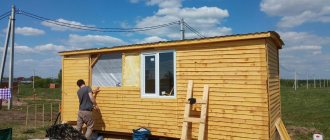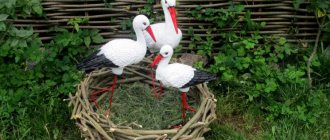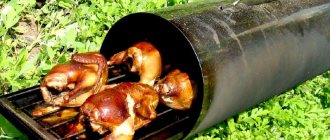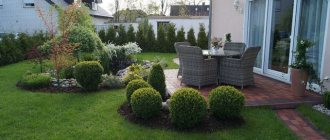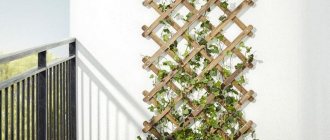It is safe to say that not a single summer cottage can do without cucumbers. Some owners grow them in greenhouses, others plant them in open ground, but any plant needs to be provided with ideal conditions and good care. For these crops, the best option is supports that simplify “care” and increase productivity. Therefore, many dacha owners are interested in what a cucumber trellis is, what materials are suitable for it, and how you can make it yourself.
Features of the use of trellis structures
Cucumber is a climbing plant of the Cucurbitaceae family, the length of its lashes can reach up to 2 m. The tendrils help it cling to everything that comes in its way. But they alone are not enough if you want to reap abundant harvests from this crop.
The best solution is special supports for cucumbers. Tying them to them allows you to provide the plant with the highest level of illumination. And this, in turn, helps to increase the number of ovaries and accelerate the formation of fruits.
If you liked the article, please share it
Previously on the topic:
Share
Advantages of growing on a trellis
It has been scientifically proven that growing cucumbers on supports specially made for this purpose is more preferable than spread out, since with a vertical arrangement the plant can completely get rid of bacteria accumulated in the soil over the winter. And even if the infection gets on the lower leaves along with water, it will not spread, but will evaporate with the moisture.
As trellis structures, you can use vertical surfaces that already exist on the site - building walls, pillars, fencing.
A do-it-yourself trellis for cucumbers can also be used when growing in a greenhouse. Such a solution brings with it a lot of advantages. It:
- saves land area;
- reduces the risk that the plant will get sick;
- accelerates the growing season;
- increases productivity;
- simplifies care and harvesting;
- facilitates movement between beds;
- prevents creases and damage to stems;
- allows you to collect clean fruits.
This cultivation method is also good because when ripe cucumbers are picked, the small thorns located on the stems injure the skin of the hands significantly less.
How to tie cucumbers in a greenhouse with your own hands: options for tying plants
It is necessary to tie cucumbers in a greenhouse, although many believe that the plants are reliably protected by the greenhouse material. Thanks to the garter, cucumbers receive more sunlight, which is especially important in greenhouse conditions.
In addition, with the help of tendrils, plants cling to each other and form balls. Mold grows in these weaves and the bushes begin to rot. This can be avoided by separating the plants. The garter allows for better development of the side branches on which the female flowers are located. This arrangement allows you to increase the yield of bushes.
The same methods are suitable for gartering in a greenhouse as for plants outside: horizontal, vertical and using a net. No less effective is the formation of plants using a combined method.
Tying cucumbers makes it possible to grow more plants in a small area.
Method of blinding cucumbers. Experienced gardeners believe that the plant should not grow uncontrollably in height and width. To do this, the main stem must be tied to a vertical support, and then all side shoots and tendrils that are located above 50 cm from the soil must be removed. Thanks to this, the cucumber will direct all its efforts to setting fruit on the main stem. The bush itself will hurt less and will not be able to block neighboring shoots. You need to tie the plant under the second leaf.
Method for polycarbonate greenhouses. A tie is used to a vertical trellis about 2 m high. The structure is attached to the side of the metal frame of the greenhouse. To make a support, you can use unnecessary fabric, cutting it into strips 2-4 cm wide. If the strips are not long enough, then this defect can be corrected by sewing individual parts or simply tying them. Such a trellis is short-lived. Instead of fabric, you can take thin twigs. Cucumber bushes cling to them well, but you will need to clear the support of knots, leaving only the main stem.
V-shaped garter. This option allows you to divide the bush in two. You should lower two twines from above and tie the cucumber at the base. After this, you need to direct the main and one large side shoot along the lowered twines and allow the plant to cling to them. This method prevents the base of the plant from becoming overgrown, so it gets sick less and receives the necessary amount of sunlight.
Scheme of garter and stem formation of a cucumber.
Rectangular trellis
The main elements are support posts and mesh. The first can be made of metal, wood, concrete, and the second can be made of metal wire, hemp rope, twine, plastic.
The mesh must be attached to the posts along the upper edge, and the lower end must be buried in the soil, pressed with tin hooks.
Disease Prevention
To successfully resist various pests of cucumbers (powdery mildew, sprout mites, aphids and others), you need to take the following measures:
- Do not plant cucumbers in the same place for 4-5 years in a row.
- Water only with warm water (room temperature).
- After harvesting, you can treat the bed with a solution of copper sulfate or any other disinfectant.
- Spray the bushes with infusions that fight pests (both purchased and made independently). For example, you can dissolve 2-3 tablespoons of soda with the same amount of laundry soap in warm water.
Round and arched designs
They are more difficult to implement. Creating an arch is especially difficult, but it looks incredibly beautiful.
The choice of a specific option depends on the amount of square meters of land allocated for supports, the selected material of manufacture and personal preferences.
How to make a wooden cucumber stand yourself
It will take approximately two hours to make. The support should be erected after planting the seeds, but before the first shoots appear.
Here are instructions on how to make a support for cucumbers:
- Decide on the type of structure.
- Install the pillars, maintaining a distance of 1.5-2 m.
- Secure the supports at an angle of 70 degrees and anchor them with guy wires.
- Build a frame by nailing a horizontal cross member to the top of the support posts.
- Perform the sheathing. It is best to use thin slats 30 mm thick for this. The optimal cell size for cucumbers is 15*15 cm.
To build a trellis for cucumbers in open ground, experts advise choosing hardwood - chestnut, oak, ash, mulberry.
You should not use birch or poplar wood - it rots quickly. To extend the life of a wooden support, before burying it in the ground, the bars should be covered with two layers of drying oil or treated with an antiseptic.
If properly designed, a cucumber trellis can adequately decorate your site, acting as a non-standard element of landscape design. Therefore, there is no need to spare time and effort on its construction.




